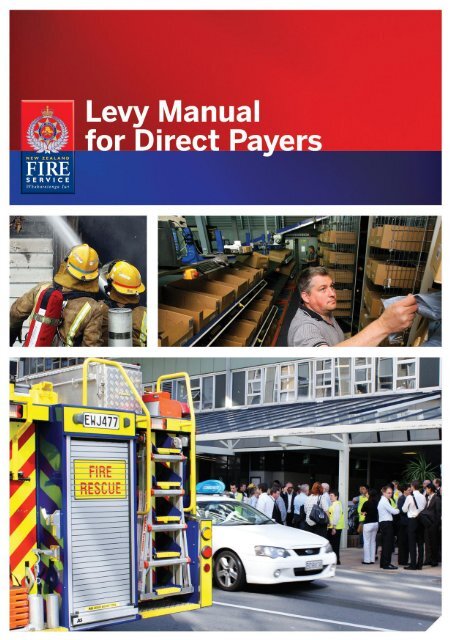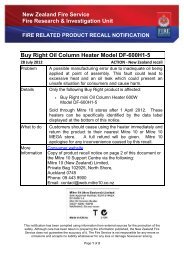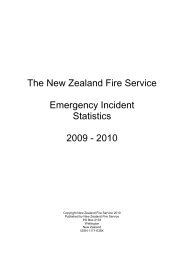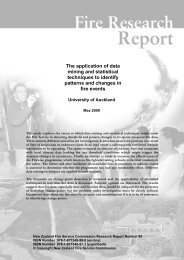A guide to the New Zealand Fire Service Levy
A guide to the New Zealand Fire Service Levy
A guide to the New Zealand Fire Service Levy
You also want an ePaper? Increase the reach of your titles
YUMPU automatically turns print PDFs into web optimized ePapers that Google loves.
<strong>Levy</strong> Manual for Direct Payers 1
<strong>Levy</strong> Manual for Direct Payers<br />
<strong>Fire</strong> <strong>Service</strong> <strong>Levy</strong> provides around 95% of <strong>the</strong> funding for <strong>the</strong> operations of <strong>the</strong> <strong>New</strong><br />
<strong>Zealand</strong> <strong>Fire</strong> <strong>Service</strong> as set out in <strong>the</strong> <strong>Fire</strong> <strong>Service</strong> Act (1975). <strong>Levy</strong> is payable on all<br />
contracts of fire insurance for all assets insured in <strong>New</strong> <strong>Zealand</strong>.<br />
<strong>Levy</strong> is currently calculated at 7.6 c per $100 sum insured. This is subject <strong>to</strong> upper limits for a number of<br />
items such as:<br />
residential buildings,<br />
domestic contents and<br />
mo<strong>to</strong>r vehicles not exceeding 3.5 <strong>to</strong>nnes gross laden weight.<br />
Where <strong>the</strong> indemnity value of <strong>the</strong> assets is less than <strong>the</strong> sum insured, levy is payable on <strong>the</strong> indemnity value.<br />
GST is payable in addition <strong>to</strong> any amount of levy. The current rate of GST is 15%.<br />
Manual Contents<br />
Who pays levy and when is it due?<br />
How is levy paid?<br />
<strong>Levy</strong> payable on mo<strong>to</strong>r vehicles<br />
<strong>Levy</strong> payable on residential buildings and personal property<br />
<strong>Levy</strong> payable on contract extensions<br />
<strong>Levy</strong> payable on all o<strong>the</strong>r assets<br />
Calculating levy<br />
Penalties<br />
Assessments and audits<br />
Items exempt under <strong>the</strong> Third Schedule<br />
<strong>Levy</strong> Manual for Direct Payers 2
Who pays levy and when is it due?<br />
All property owners who insure property in <strong>New</strong> <strong>Zealand</strong> against <strong>the</strong> risk of fire pay a levy.<br />
Responsibility for calculating and making payment of <strong>the</strong> <strong>Fire</strong> <strong>Service</strong> levy depends on how <strong>the</strong> insurance<br />
cover is being arranged.<br />
Where <strong>the</strong>re is a <strong>New</strong> <strong>Zealand</strong>-based insurer involved in <strong>the</strong> policy, levy is payable by <strong>the</strong> insurer<br />
(based upon <strong>the</strong> proportion of insurance).<br />
Where <strong>the</strong>re is not a <strong>New</strong> <strong>Zealand</strong>-based insurer, but <strong>the</strong>re is a <strong>New</strong> <strong>Zealand</strong>-based broker, levy is<br />
payable by <strong>the</strong> broker<br />
In all o<strong>the</strong>r circumstances, levy is payable <strong>to</strong> <strong>the</strong> Commission by <strong>the</strong> insured.<br />
The forms that should be sent with, or shortly after <strong>the</strong> payment of levy by <strong>the</strong> insured are:<br />
SITUATION FORMS REQUIRED<br />
Where <strong>the</strong>re is a contract of fire insurance<br />
covering assets<br />
Where <strong>the</strong>re is a provision or reserve set aside <strong>to</strong><br />
cover loss by fire or where <strong>the</strong>re are any o<strong>the</strong>r<br />
arrangements similar <strong>to</strong> a contract of fire<br />
insurance<br />
Form 2, Form 3,<br />
Form 4, Form 5,<br />
<strong>Fire</strong> <strong>Service</strong> <strong>Levy</strong> is due on <strong>the</strong> 15th day of <strong>the</strong> second month following commencement of <strong>the</strong> policy. For<br />
example, if a policy covers <strong>the</strong> insurance period 30 June 2012 <strong>to</strong> 30 June 2013, levy is payable in full on 15<br />
August 2012, regardless of when <strong>the</strong> premium is paid.<br />
The NZFS uses advertising <strong>to</strong> alert <strong>the</strong> public <strong>to</strong> <strong>the</strong>ir obligation <strong>to</strong> pay levy and sends reminder letters <strong>to</strong><br />
people who have previously paid levy. However, <strong>the</strong> calculation and payment of levy ultimately falls on <strong>the</strong><br />
party that is responsible for payment.<br />
<strong>Levy</strong> Manual for Direct Payers 3
How is levy paid?<br />
We prefer payments by direct credit <strong>to</strong> <strong>the</strong> <strong>New</strong> <strong>Zealand</strong> <strong>Fire</strong> <strong>Service</strong> bank account:<br />
<strong>New</strong> <strong>Zealand</strong> <strong>Fire</strong> <strong>Service</strong> Commission<br />
Bank of <strong>New</strong> <strong>Zealand</strong><br />
North End Branch – Welling<strong>to</strong>n<br />
02-0536-0062111-00<br />
SWIFT: BKNZNZ22<br />
Payments can be also be made via cheque <strong>to</strong>:<br />
The Revenue Team<br />
<strong>New</strong> <strong>Zealand</strong> <strong>Fire</strong> <strong>Service</strong><br />
PO Box 2133<br />
Welling<strong>to</strong>n 6140<br />
Please ensure that <strong>the</strong> word ―levy‖ and <strong>the</strong> period that <strong>the</strong> payment relates <strong>to</strong> (i.e. 2010/11) are included in<br />
<strong>the</strong> explanation field.<br />
Common errors when calculating and paying levy include –<br />
Calculating <strong>the</strong> levy due based on <strong>the</strong> premium ra<strong>the</strong>r than <strong>the</strong> Indemnity Value or Sum Insured<br />
Not including GST or not calculating GST correctly<br />
Not calculating levy in $NZD<br />
Paying from offshore and not ensuring bank fees/costs are paid in full by <strong>the</strong> levy payer<br />
All payments of levy that are calculated and paid directly <strong>to</strong> <strong>the</strong> <strong>New</strong> <strong>Zealand</strong> <strong>Fire</strong> <strong>Service</strong> must be<br />
accompanied by <strong>the</strong> appropriate forms as shown in <strong>the</strong> table in <strong>the</strong> previous section.<br />
The Statu<strong>to</strong>ry Declaration must be witnessed by a Justice of <strong>the</strong> Peace, a notary public, a person enrolled as<br />
a barrister and solici<strong>to</strong>r of <strong>the</strong> High Court or any o<strong>the</strong>r person authorised <strong>to</strong> witness a Statu<strong>to</strong>ry Declaration<br />
under <strong>the</strong> Oaths and Declarations Act 1957.<br />
Copies of <strong>the</strong>se forms are downloadable from our website, http://www.fire.org.nz under <strong>the</strong> levy section.<br />
<strong>Levy</strong> payable on mo<strong>to</strong>r vehicles<br />
<strong>Levy</strong> is payable at a flat rate of $6.08 per mo<strong>to</strong>r vehicle not exceeding 3.5 <strong>to</strong>nnes gross laden weight.<br />
Definitions of <strong>the</strong> terms are in <strong>the</strong> Land Transport Act and Road User Charges Act.<br />
<strong>Levy</strong> on all o<strong>the</strong>r ‗vehicles‘ (over 3.5 <strong>to</strong>nnes gross laden weight) is calculated in <strong>the</strong> same manner as 'o<strong>the</strong>r<br />
property'.<br />
<strong>Levy</strong> Manual for Direct Payers 4
<strong>Levy</strong> payable on residential buildings and personal property<br />
<strong>Fire</strong> <strong>Service</strong> <strong>Levy</strong> is payable on all assets insured against <strong>the</strong> risk of fire, but residential buildings and<br />
personal property are subject <strong>to</strong> a limit.<br />
Section 48(6) of <strong>the</strong> <strong>Fire</strong> <strong>Service</strong> Act states that <strong>the</strong> amount for which <strong>the</strong> property is insured for <strong>the</strong> contract<br />
of fire insurance shall be—<br />
(a) In <strong>the</strong> case of residential building as defined in section 2(1) of <strong>the</strong> Earthquake Commission Act<br />
1993, <strong>the</strong> amount for which that building is insured pursuant <strong>to</strong> section 18 of that Act:<br />
(b) In <strong>the</strong> case of personal property as defined in section 2(1) of <strong>the</strong> Earthquake Commission Act<br />
1993, <strong>the</strong> amount for which that property is insured pursuant <strong>to</strong> section 20 of that Act:<br />
Clarification on <strong>the</strong> types of buildings that are subject <strong>to</strong> a limit are in <strong>the</strong> Earthquake Commission <strong>guide</strong> at:<br />
http://www.eqc.govt.nz/sites/public_files/insurers-<strong>guide</strong>-september-2012.pdf<br />
<strong>Levy</strong> payable on contract extentions<br />
<strong>Levy</strong> is payable on policy extensions if <strong>the</strong>y increase <strong>the</strong> sum insured during <strong>the</strong> policy period. The two most<br />
common examples of <strong>the</strong>se types of extensions are contract works and capital additions. All levy payable<br />
should be assessed on <strong>the</strong>se types of insurance and it is payable at <strong>the</strong> inception of <strong>the</strong> policy and for <strong>the</strong><br />
period of <strong>the</strong> insurance.<br />
Where <strong>the</strong> extensions are not fully utilised during <strong>the</strong> period of insurance, <strong>the</strong> unused portion of levy may be<br />
offset against <strong>the</strong> levy payable for <strong>the</strong> current period. Given this may be subject <strong>to</strong> an audit, appropriate<br />
records must be kept.<br />
Where <strong>the</strong> amount of <strong>the</strong> sum insured under <strong>the</strong> contract extension represents <strong>the</strong> estimated completed<br />
value of all of <strong>the</strong> property, that amount shall be used as <strong>the</strong> indemnity value of that property. For any global<br />
policies, <strong>the</strong> amount shown in <strong>the</strong> policy shall be used, unless a local (NZ) limit is specified.<br />
Contract works policies<br />
No variation or discount of levy is allowed for existing completed property that is also insured within a<br />
contract works insurance policy, as levy is payable on all contracts of fire insurance.<br />
Where work is being undertaken on properties that are subject <strong>to</strong> limits or exempted, <strong>the</strong>n <strong>the</strong> amount of levy<br />
may be reduced (see calculations below). Where work is being done on exempted assets, it does not<br />
au<strong>to</strong>matically make <strong>the</strong> contract works policy exempt from levy, as <strong>the</strong> policy would provide fire cover for<br />
assets o<strong>the</strong>r than what is being built.<br />
If <strong>the</strong> construction insurance continues <strong>to</strong> apply after <strong>the</strong> end of <strong>the</strong> period of construction and/or during any<br />
period of maintenance, levy will be calculated on that value without discount for <strong>the</strong> period of that insurance.<br />
<strong>Levy</strong> Manual for Direct Payers 5
There are two methods for calculating contract works levy. These are:<br />
Option A<br />
The sum insured shall be deemed <strong>to</strong> represent <strong>the</strong> indemnity value of <strong>the</strong> property<br />
and levy shall be calculated on that value. A discount fac<strong>to</strong>r of 50% is applied <strong>to</strong> reflect <strong>the</strong> fact that <strong>the</strong> value<br />
of <strong>the</strong> works undertaken increases progressively over <strong>the</strong> period. This value is <strong>the</strong>n pro-rated for <strong>the</strong> period<br />
of <strong>the</strong> insurance contract.<br />
Assuming a sum insured of $2 million for a period of insurance of 6 months, levy payable under this option<br />
would be $380, calculated as follows:<br />
Sum Insured (multiplied by) $2,000,000<br />
<strong>Levy</strong> Rate (multiplied by) 7.6 cents per $100 insured<br />
Pro rata period (multiplied by) 50%<br />
Period of cover 6/12 months<br />
Option B<br />
Option B allows for levy <strong>to</strong> be calculated based upon an estimated value of property at <strong>the</strong> end of each<br />
applicable period. Given <strong>the</strong>se are estimates of <strong>the</strong> work that should be completed; <strong>the</strong> levy rate applies <strong>to</strong><br />
<strong>the</strong> estimated values without <strong>the</strong> benefit of <strong>the</strong> 50% discount.<br />
Assuming <strong>the</strong> same circumstances as above, but that <strong>the</strong> value of work completed in each of <strong>the</strong> first two<br />
months would be $500,000, and <strong>the</strong>reafter at $250,000 per month, levy under this option would be $506.67,<br />
calculated as follows:<br />
Estimated month end value (multiplied by) $500,000 - $2,000,000<br />
<strong>Levy</strong> rate (multiplied by) 7.6 cents per $100 insured<br />
Period of cover 1/12 months<br />
Month Estimated Month End Value <strong>Levy</strong> Payable<br />
1 $500,000 $31.67<br />
2 $1,000,000 $63.34<br />
3 $1,250,000 $31.67<br />
4 $1,500,000 $63.33<br />
5 $1,750,000 $79.17<br />
6 $2,000,000 $95.00<br />
This form of insurance insures property while it is being constructed. If <strong>the</strong> period of construction is for more<br />
than one year, <strong>the</strong>n <strong>the</strong> discount of 50% will not apply <strong>to</strong> any work that is completed and continues <strong>to</strong> be<br />
insured in any subsequent period(s). The Insured shall make a declaration <strong>to</strong> <strong>the</strong> Insurer so that a premium<br />
adjustment may be made <strong>to</strong> reflect <strong>the</strong> actual value of work undertaken.<br />
<strong>Levy</strong> Manual for Direct Payers 6
<strong>Levy</strong> payable on all o<strong>the</strong>r assets<br />
<strong>Levy</strong> is payable on all assets insured against <strong>the</strong> risk of fire. Assets are not limited <strong>to</strong> buildings and include<br />
s<strong>to</strong>ck, plant and equipment and anything else insured against <strong>the</strong> risk of fire. The Third Schedule of <strong>the</strong> <strong>Fire</strong><br />
<strong>Service</strong> Act contains a list of items that are exempt from levy.<br />
Where an item is not exempt and is not subject <strong>to</strong> limits, levy is payable at <strong>the</strong> rate of 7.6 cents per $100 of<br />
assets insured. The value of assets insured is generally calculated using <strong>the</strong> sum insured, but where<br />
settlement of <strong>the</strong> claim is no more favourable than <strong>the</strong> sum insured, it can also be calculated on <strong>the</strong><br />
indemnity value of <strong>the</strong> assets covered by <strong>the</strong> policy.<br />
The indemnity inflation fac<strong>to</strong>r is deemed <strong>to</strong> be part of <strong>the</strong> indemnity value. So, whenever inflation is insured<br />
in an indemnity value contract of fire insurance <strong>the</strong> levy is deemed payable (less <strong>the</strong> same discount up <strong>to</strong> a<br />
maximum of 50%) that <strong>the</strong> insurer has applied in determining <strong>the</strong> premium rating for <strong>the</strong> contract of<br />
insurance.<br />
Calculating <strong>Fire</strong> <strong>Service</strong> <strong>Levy</strong><br />
This simple table is designed <strong>to</strong> help you think about <strong>the</strong> issues that are involved with <strong>the</strong> calculation of levy:<br />
Sum insured under <strong>the</strong> contract<br />
(or indemnity value of assets plus any applicable inflation)<br />
Less<br />
Items exempt from levy<br />
Items subject <strong>to</strong> limits<br />
Primary levy liability<br />
Add levy on items subject <strong>to</strong> limits<br />
Residential buildings<br />
Personal property<br />
Mo<strong>to</strong>r vehicles<br />
<strong>Levy</strong> on assets<br />
Add levy on limits and extensions<br />
Contract works<br />
Capital additions<br />
Annual levy liability<br />
Multiply by period of cover<br />
<strong>Levy</strong> payable<br />
Add GST (currently 15%)<br />
Total amount payable <strong>to</strong> <strong>the</strong> NZFS Commission<br />
<strong>Levy</strong> Interest and Surcharge<br />
If a payment is late, interest may be charged at 1.5% per month, or pro rata for each part month <strong>the</strong> levy is<br />
late. If <strong>the</strong> levy payment is over 6 months late, a surcharge of 10% plus GST must be added <strong>to</strong> <strong>the</strong><br />
outstanding levy. This surcharge is charged for every period of six months that <strong>the</strong> levy payment is late. The<br />
surcharge will continue <strong>to</strong> accrue on any unpaid amount (excluding interest) until <strong>the</strong> outstanding levy has<br />
been paid.<br />
Interest and surcharges are calculated on <strong>the</strong> GST-inclusive value of <strong>the</strong> outstanding/late levy value. Any<br />
payments that are received after <strong>the</strong> 15 th of <strong>the</strong> month are deemed late under <strong>the</strong> Act.<br />
When a levy payment has been identified as being late or a shortfall has been identified, an invoice will be<br />
issued for any levy arrears, interest, surcharge and GST where applicable.<br />
<strong>Levy</strong> Manual for Direct Payers 7
Assessments and audits<br />
When <strong>the</strong> relevant forms accompanying <strong>the</strong> levy payment are submitted, an initial review of <strong>the</strong> calculation is<br />
performed. This review checks <strong>the</strong> payment for timeliness, completeness of information and accuracy. You<br />
may receive a phone call or a follow up letter requesting fur<strong>the</strong>r information.<br />
In addition, a selection of brokers, insurance companies and companies that make payments directly <strong>to</strong> <strong>the</strong><br />
<strong>Fire</strong> <strong>Service</strong> are audited by <strong>the</strong> <strong>Fire</strong> <strong>Service</strong>. In <strong>the</strong> event that you are selected for an audit, one of our staff<br />
will be in <strong>to</strong>uch two weeks before <strong>the</strong> intended start date.<br />
Most compliance audits will not require our attendance at your premises. Under section 51 of <strong>the</strong> Act, you<br />
are required <strong>to</strong> keeping full particulars of each contract of fire insurance and <strong>the</strong> amount of <strong>the</strong> levy and date<br />
of its payment <strong>to</strong> <strong>the</strong> Commission. These documents must be presented when requested as part of a<br />
compliance audit.<br />
Items exempt under <strong>the</strong> Third Schedule<br />
Some items of property are exempt from levy. Please note that <strong>the</strong>se exemptions are very specific and <strong>the</strong><br />
NZ <strong>Fire</strong> <strong>Service</strong> recommends you contact <strong>the</strong> levy analyst on (04) 496-3656 or e-mail<br />
levy.analyst@fire.org.nz for specific advice on any items you intend exempted from levy. Shortfalls of levy<br />
as a result of property being incorrectly exempt will result in late payment penalties as outlined in <strong>the</strong> Act.<br />
Any ship or anything in a ship, except while <strong>the</strong> ship is on land:<br />
Any standing bush or forest:<br />
Any road, street or path:<br />
Any railway track or pole, or any tramway track or pole:<br />
Any bridge or viaduct ei<strong>the</strong>r completed or in course of construction, or any boxing or falsework used in<br />
construction of any bridge or viaduct:<br />
Any tunnel or cutting:<br />
Any retaining wall, dam, breakwater, mole, groyne, fence or wall:<br />
Any drain or channel:<br />
Any reservoir, swimming bath, water tank (o<strong>the</strong>r than a water tank installed as part of <strong>the</strong> water supply<br />
system of any dwelling or farm building), water <strong>to</strong>wer, or septic tank:<br />
Any water reticulation pipe (o<strong>the</strong>r than a water reticulation pipe which in <strong>the</strong> opinion of <strong>the</strong> Earthquake<br />
and War Damage Commission, constitutes a structural part of any building):<br />
Any electric supply, telegraph or telephone pole, line or cable:<br />
Any mine or quarry:<br />
Any aircraft or anything in an aircraft except while insured under a contract which is substantially a<br />
contract of fire insurance:<br />
Any goods in transit, except while insured under a contract which is substantially a contract of fire<br />
insurance:<br />
Any hazardous substance (as defined in Section 2 of <strong>the</strong> Hazardous Substances and <strong>New</strong> Organisms<br />
Act 1996):<br />
Any lives<strong>to</strong>ck:<br />
Any growing crops (including fruit trees and vines):<br />
Any ensilage insured in <strong>the</strong> open field:<br />
Any hay or o<strong>the</strong>r cut crops insured in <strong>the</strong> open field:<br />
Any offshore installation for petroleum mining operations as defined in <strong>the</strong> Petroleum Act 1937:<br />
Any pipeline, electricity cable, or telecommunications cable which is located on <strong>the</strong> sea floor.<br />
<strong>Levy</strong> Manual for Direct Payers 8
O<strong>the</strong>r items exempt from levy<br />
The <strong>Fire</strong> <strong>Service</strong> also considers <strong>the</strong> following not <strong>to</strong> be property within <strong>the</strong> definition of <strong>the</strong> Act, and <strong>the</strong>refore<br />
no levy is payable on:<br />
Demolition costs<br />
Fees<br />
Expediting costs following a claim<br />
Cost of property protection following a claim<br />
Money<br />
Employees <strong>to</strong>ols and personal effects<br />
Employees vehicles whilst in use on insured‘s business<br />
<strong>Levy</strong> Manual for Direct Payers 9
Glossary of terms<br />
"Act" is <strong>the</strong> <strong>Fire</strong> <strong>Service</strong> Act (1975)<br />
―Book value‖ – is <strong>the</strong> cost or adjusted value of an asset in <strong>the</strong> financial records of a company. This value is never used in <strong>the</strong> calculation<br />
of <strong>Fire</strong> <strong>Service</strong> levy unless a company adjusts book value <strong>to</strong> reflect replacement values.<br />
"Commencement date" is <strong>the</strong> date from which <strong>the</strong> policy applies<br />
―Commission‖ is <strong>the</strong> <strong>New</strong> <strong>Zealand</strong> <strong>Fire</strong> <strong>Service</strong> Commission<br />
“Contract of <strong>Fire</strong> Insurance” means an agreement whereby any property is insured against loss or damage from fire, whe<strong>the</strong>r <strong>the</strong><br />
agreement includes o<strong>the</strong>r risks or not; but does not include any contract of marine insurance or any contract of reinsurance<br />
"EQC" is <strong>the</strong> Earthquake Commission<br />
"EQC Act" is Earthquake Commission Act (1993)<br />
―Exempt assets‖ are those set out in <strong>the</strong> Third Schedule of <strong>the</strong> Act. No <strong>Fire</strong> <strong>Service</strong> levy is payable on exempt assets.<br />
―GST‖ is <strong>the</strong> Goods and <strong>Service</strong>s Tax prescribed under <strong>the</strong> Goods and <strong>Service</strong>s Tax Act 1985<br />
"Indemnity value" represents <strong>the</strong> value of <strong>the</strong> item at <strong>the</strong> time of <strong>the</strong> loss. Given it is an estimate of <strong>the</strong> amount that you would be paid in<br />
<strong>the</strong> event of a loss, it is often not specified in insurance contracts, but generally ascertained by a valuation.<br />
It is calculated as <strong>the</strong> replacement cost of an asset less an allowance for <strong>the</strong> depreciation/ condition of <strong>the</strong> asset, and is designed <strong>to</strong> put<br />
you in <strong>the</strong> same financial position you were in immediately before <strong>the</strong> loss occurred.<br />
“Insurance Company” is defined under Section 2 of <strong>the</strong> <strong>Fire</strong> <strong>Service</strong> Act, and includes any company, corporation, or partnership which,<br />
or person who,—<br />
(i) Undertakes any liability under any contract of fire insurance (o<strong>the</strong>r than marine insurance), whe<strong>the</strong>r exclusively or in conjunction with<br />
any o<strong>the</strong>r business; or<br />
(ii) Accepts a payment in respect of any property <strong>to</strong> provide indemnity or a reserve <strong>to</strong> cover future loss or future damage resulting from<br />
circumstances which include loss or damage from fire, or for any o<strong>the</strong>r purpose similar or analogous <strong>to</strong> a contract of fire insurance; or<br />
(iii) Makes provision for <strong>the</strong> establishment of a fund <strong>to</strong> provide indemnity <strong>to</strong> cover future loss or future damage resulting from<br />
circumstances which include loss or damage from fire, or for any o<strong>the</strong>r purpose similar or analogous <strong>to</strong> a contract of fire insurance; or<br />
(iv) Issues any cover note in respect of a contract of fire insurance or gives any information that insurance, which includes cover from<br />
fire, has been effected, or issues any receipt acknowledging <strong>the</strong> receipt of a premium in respect of a contract of fire insurance, or<br />
receives any premiums, proposals, or requests for insurance which includes cover from fire;<br />
"<strong>Levy</strong>" is <strong>Fire</strong> <strong>Service</strong> levy<br />
―Market value‖ is <strong>the</strong> price that would be paid in a competitive auction setting. Market value is sometimes used interchangeably with<br />
indemnity value although <strong>the</strong>se terms are not always identical.<br />
“Mixed-use Building” – is a building that is used for both residential and commercial purposes<br />
“Mo<strong>to</strong>r Vehicle” - means a mo<strong>to</strong>r vehicle as defined in section 2(1) of <strong>the</strong> Land Transport Act 1988<br />
―NZFS‖ is <strong>the</strong> <strong>New</strong> <strong>Zealand</strong> <strong>Fire</strong> <strong>Service</strong><br />
“Owner of Property” includes any company, corporation, partnership, or person who is entitled <strong>to</strong> legal or beneficial ownership of, or is<br />
entitled <strong>to</strong> any form of tenure, possession, or right <strong>to</strong>, any such property. It includes any company, corporation, partnership, or person,<br />
whe<strong>the</strong>r resident in <strong>New</strong> <strong>Zealand</strong> or not, who is entitled <strong>to</strong> any indemnity or benefit under any contract of fire insurance, whe<strong>the</strong>r or not<br />
<strong>the</strong>y are entitled <strong>to</strong> any form of legal or beneficial ownership or <strong>to</strong> any form of tenure, possession, or right<br />
―Rate of levy‖ is <strong>the</strong> amount set out in <strong>the</strong> most recent <strong>Fire</strong> <strong>Service</strong> <strong>Levy</strong> Amendment Order. The current rate is 7.6c per $100 insured.<br />
"Replacement cost/value" is <strong>the</strong> amount that would be covered by insurance <strong>to</strong> obtain a new similar or identical item <strong>to</strong> replace <strong>the</strong><br />
damaged item.<br />
“Residential Property” – is defined under Section 2(1) of <strong>the</strong> Earthquake Commission Act (1993)<br />
“Shortfall” is <strong>the</strong> difference between <strong>the</strong> amount of levy paid and <strong>the</strong> amount of levy assessed as payable by <strong>the</strong> <strong>New</strong> <strong>Zealand</strong> <strong>Fire</strong><br />
<strong>Service</strong> Commission and/or its agents<br />
―Sum insured‖ is <strong>the</strong> amount shown on <strong>the</strong> policy as <strong>the</strong> sum insured.<br />
<strong>Levy</strong> Manual for Direct Payers 10
















